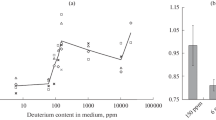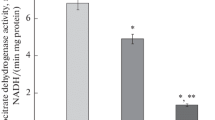Abstract
Appelmans and de Duve1 found that the ‘osmotic activation’ or lysis undergone by rat liver mitochondria in hypotonic media could be prevented by the presence in the medium of 0.25 M sucrose; the sucrose could be partly replaced by an iso-osmolar quantity of β-glycerophosphate. They showed that mitochondria released certain enzymes as a result of osmotic activation. If deoxyribonuclease, which Schneider and Hogeboom2 have shown to be largely associated in liver with mitochondria, is also released by osmotic activation, this might explain the effectiveness of sucrose in media for the isolation and preservation of nuclei. Anderson3 has shown that sucrose prevents ‘bleb’ or bubble formation on the nuclear surface, and that bleb formation occurs on nuclei treated with deoxyribonuclease.
Similar content being viewed by others
References
Appelmans, F., and de Duve, C., Biochem. J., 59, 426 (1955).
Schneider, W. C., and Hogeboom, G. H., J. Biol. Chem., 198, 155 (1952).
Anderson, N. G., Exp. Cell. Res., 4, 306 (1953); 5, 361 (1953).
Author information
Authors and Affiliations
Rights and permissions
About this article
Cite this article
PHILPOT, J., STANIER, J. Preservation of Rat Liver Nuclei by Potassium Glycerophosphate. Nature 176, 1128–1129 (1955). https://doi.org/10.1038/1761128b0
Issue Date:
DOI: https://doi.org/10.1038/1761128b0
- Springer Nature Limited





